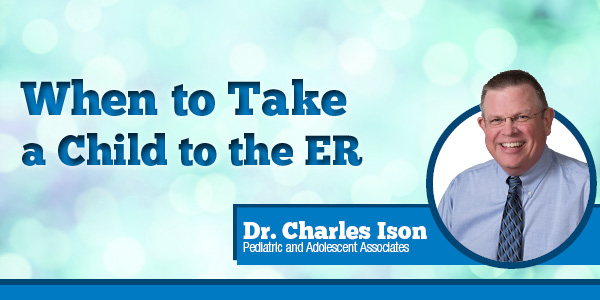When to Take a Child to the ER
Emergencies happen to people. Children are no exception. According to The American Academy of Pediatrics: “An emergency is when you believe a severe injury or illness is threatening your child’s health or may cause permanent harm.”
There are some situations that nearly everyone would agree warrant a child being seen in an Emergency Department. Others may not be so clear cut.
There are some rules of thumb, though, that can help caregivers in making this important decision.
Certain accidents usually warrant an ER visit. These include car crashes, smoke inhalation, choking, near drowning, firearm or other weapon injury, electric shock, more severe bicycle wrecks, and more severe falls.
Any head trauma that results in any loss of consciousness, confusion or recurrent vomiting should be evaluated in the ER.
The same goes for any rhythmic jerking with loss of consciousness (possible seizure). Neck or spine injuries should also be evaluated.
Large or deep cuts should also be evaluated, especially if they involve the head, chest or abdomen. So should bleeding that does not stop after holding direct pressure for five minutes.
Large burns should be evaluated in an ER, especially if they involve the face, chest, groin, hands or feet.
Shortness of breath and respiratory distress are emergencies. If the skin or the lips are gray, blue or purple, the child should be evaluated.
Severe dehydration warrants a trip to the ER. So does a rapid heart rate that will not slow down. Fever with a stiff neck should have ER evaluation. So should fever with a rash.
A change in mental status should also be evaluated. This can include bizarre behavior, unusual sleepiness, being difficult (or impossible) to awaken, acting disoriented or confused.
Ingestion of a poison, ingestion of another’s medication or an overdose of a medication may warrant an ED evaluation.
Poison Control (1-800-222-1222) is a helpful resource and can be consulted as to whether a trip to the ED is necessary for an ingestion of a known substance. The container for the substance should be brought to the ER with the child if possible.
One of the most important things in dealing with an emergency is for the child’s caregiver to remain calm. Knowing CPR in these situations can be helpful because it can help give a caregiver a stepwise approach to dealing with the emergency. The American Red Cross and The American Heart Association both teach it.
Dr. Charles Ison is a University of Kentucky graduate who has practiced in his hometown of Lexington since 1993. He is a partner in Pediatric and Adolescent Associates.

